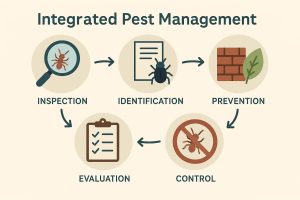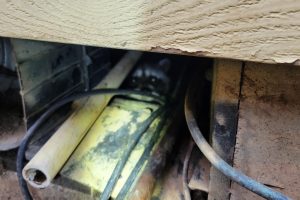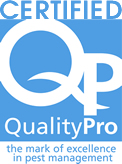If you’ve spent any time talking with us here at Good Earth Pest Company, you’ve probably heard the term IPM come up more than once. It stands for Integrated Pest Management, and while it might sound like a buzzword, it’s actually the foundation for just about everything we do—whether we’re handling ants in your kitchen, rats in your crawlspace, or raccoons in your attic.
So, what exactly is IPM? And how does it show up in our day-to-day work across homes, businesses, insects, rodents, and wildlife? Let’s break it down.
Key Takeaways
- IPM stands for Integrated Pest Management—a smart, strategic, and sustainable approach to pest control.
- It means solving pest problems by understanding the pest, modifying the environment, and using the least toxic method possible.
- Good Earth applies IPM across the board—residential and commercial, insect and rodent, structural and wildlife.
The Core of IPM: Know It Before You Control It
At its heart, IPM is about asking questions before taking action:
- What pest are we dealing with?
- Why is it here?
- What conditions are helping it thrive?
- How do we prevent it from becoming a problem again?
Instead of reaching for a spray first, we gather information, monitor activity, identify contributing factors, and then build a plan that uses multiple tools—not just pesticides—to get lasting results.

IPM is a smart, science-based approach that focuses on long-term pest prevention using inspection, identification, prevention, and targeted control.
Residential Pest Control: Keeping Homes Safe with a Lighter Touch
Whether it’s odorous house ants trailing across the baseboards or spiders spinning webs in the eaves, we take a prevent-first approach in homes. That means:
- Sealing up entry points like gaps in siding or foundation cracks.
- Modifying moisture levels, improving ventilation in crawlspaces and attics.
- Cleaning up attractants like food scraps, pet food, or cluttered storage.
- Only targeted product application when and where it’s needed—and nothing more.
We don’t do unnecessary treatments. IPM allows us to solve pest problems without blanketing your home in chemicals.
Commercial IPM: Protecting Businesses with Smart Systems
In commercial settings—like restaurants, offices, fitness centers, schools, hotels, and breweries—the stakes are higher. A pest sighting could mean a bad review, a health code violation, or a PR nightmare.
That’s why our commercial clients get customized pest management plans built on core IPM principles:
- Regular inspections and ongoing monitoring with traps, sensors, and activity logs.
- Communication and documentation with staff to catch issues early.
- Sanitation support—we’ll point out spills, leaks, or storage issues that can attract pests.
- Product selection that’s effective but discreet, safe for public areas, and appropriate for the space.
Our commercial programs are all about sustainability, safety, and documentation. We don’t just “treat”—we manage.
Insect IPM: Beyond the Spray
For insect pests, especially in and around structures, IPM gives us a toolbox instead of just a hammer.
When it comes to ants, cockroaches, stinging insects, flies, and pantry pests, we’re looking at:
- Food and water sources—how can we eliminate them?
- Entry points and harborages—can we exclude or remove them?
- Monitoring tools like sticky traps and pheromone traps to track activity.
- Targeted baits, growth regulators, and low-impact insecticides—only when needed, and only where they’re most effective.
We’re not out here soaking your siding “just in case.” Everything we do is based on observation, diagnosis, and strategy.
Rodent IPM: Thinking Like a Rat
Rodents aren’t just a nuisance—they’re smart, adaptable, and good at surviving. So, our approach to rats and mice needs to be just as strategic.
Good Earth’s rodent IPM approach includes:
- Exclusion first—sealing up vents, gaps, utility penetrations, and crawlspace entries.
- Habitat modification—reducing clutter, vegetation, and food sources around the property.
- Monitoring—with traps, tracking powders, and non-toxic bait blocks to see what’s going on.
- Trapping and baiting, but only after we’ve set the stage to make those efforts effective.
We also take extra care with rodenticide use. All bait is placed in tamper-resistant stations, and we prioritize cholecalciferol-based baits and other low-secondary-risk options. We’re not about casual bait tossing—we’re about thoughtful, responsible control.
Wildlife IPM: Coexisting and Controlling Humanely
When wildlife becomes a problem—raccoons in the attic, skunks under the deck, gophers in the garden—IPM is more important than ever. These aren’t insects. They’re intelligent, adaptable animals. Control needs to be handled with knowledge, respect, and often, patience.

A raccoon peers out of a foundation vent, a reminder of how vulnerable crawlspaces can be without proper exclusion.
Wildlife IPM means:
- Identifying the species and behavior patterns (Are they nesting? Feeding? Traveling?)
- Exclusion—think chimney caps, crawlspace screening, and repairs.
- Trapping or eviction, depending on the animal and the situation.
- Habitat correction, like removing food sources, standing water, or shelter.
- Ongoing monitoring to ensure they don’t come back.
We follow all relevant laws and best practices and always look for the most humane, effective solution.
DIY IPM Checklist: What You Can Do
Keep It Clean
– Wipe down surfaces regularly
– Clean up crumbs and spills immediately
– Take out trash often and keep bins sealedSeal It Up
– Add door sweeps and weather stripping
– Seal gaps around pipes, wires, and vents
– Repair broken screens and cracks in sidingCut Back Vegetation
– Trim trees and bushes away from your structure
– Remove ivy and vines climbing your walls
– Avoid dense groundcover near foundationsStore Smart
– Use airtight containers for pantry items
– Keep pet food sealed and off the ground
– Rotate stock to avoid expired or infested goodsFix Moisture Issues
– Repair leaky faucets, pipes, and hoses
– Clear gutters and downspouts
– Avoid overwatering garden beds and plantersKeep an Eye Out
– Report droppings, chewed materials, or frass
– Monitor for new ant trails, mounds, or nesting
– Ask questions—early detection = fewer treatments
Final Thoughts: Why IPM Works
Integrated Pest Management isn’t a sales pitch—it’s a philosophy. It’s how we do better pest control with fewer chemicals, longer-lasting results, and more thoughtful solutions.
From residential clients who want peace of mind to commercial partners who need accountability, IPM helps us serve people—not just treat pests.
If you’re looking for a pest control company that’s focused on long-term success instead of short-term sprays, you’re in the right place. Give us a call—we’re happy to show you what IPM looks like in action.
We’re Good Earth Pest Company. And this is how we do it
~ Adam Hiddleson



